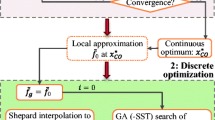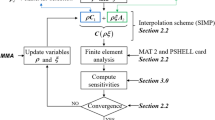Abstract
An efficient procedure to obtain the optimal stacking sequence and the minimum weight of stiffened laminated composite curved panels under several loading conditions and stiffener layouts has been developed based on the finite element method and the genetic algorithm that is powerful for the problem with integer variables. Often, designing composite laminates ends up with a stacking sequence optimization that may be formulated as an integer programming problem. This procedure is applied for a problem to find the stacking sequence having a maximum critical buckling load factor and the minimum weight. The object function in this case is the weight of a stiffened laminated composite shell. Three different types of stiffener layouts with different loading conditions are investigated to see how these parameters influence on the stacking sequence optimization of the panel and the stiffeners. It is noticed from the results that the optimal stacking sequence and lay-up angles vary depending on the types of loading and stiffener spacing.
Similar content being viewed by others
References
Gürdal, Z., Haftka, R. T. and Hajela, P., 1999,Design and Optimization of Laminated Composite Material, John Wiley & Sons Inc., New York.
Kang, J. H., Kim, J. S., Kong, C. W., Kim, C. G. and Hong, C. S., 2000, “Optimal Design of Compressively Loaded Stiffened Composite Panels using Genetic Algorithm,”Journal of The Korean Society for Aeronautical and Space Sciences, Vol. 28, No. 3, pp. 72–81.
Le Riche, R. and Haftka, R. T., 1993, “Optimization of Laminated Stacking Sequence for Buckling Load Maximization by Genetic Algorithm,”AIAA Journal, Vol. 31, No. 5, pp. 951–956.
Liu, B., Haftka, R.T., Akgün, M. A. and Todoroki, A., 2000, “Permutation Genetic Algorithm for Stacking Sequence Design of Composite Laminates,”Comput. Methods Appl. Mech. Engrg., Vol. 186, pp. 357–372.
Nagendra, S., Jestin, D., Gürdal, Z., Haftka, R. T. and Watson, L. T., 1996, “Improved Genetic Algorithm for the Design of Stiffened Composite Panels,”Computers and Structures, Vol. 58, pp. 543–555.
Soremenkun, G., Gürdal, Z., Haftka, R. T. and Watson, L. T., 2001, “Composite Laminate Design Optimization by Genetic Algorithm with Generalized Elitist Selection,”Computers and Structures, Vol. 79, pp. 131–143.
Soremenkun, G., Gürdal, Z., Kassapoglou, C. and Toni, D., 2001, “Stacking Sequence Blending of Multiple Composite Laminates Using Genetic Algorithm,”Proc. 42nd AIAA/ASME/ASCE/ AHS/ASC SDM. Conf., Seattle, WA, AIAA 2001–1203.
Todoroki, A. and Sasai, M., 1999, “Improvement of Design Reliability for Buckling Load Maximization of Composite Cylinder Using Genetic Algorithm with Recessive-Gene-Like Repair,”JSME International Journal, Series A, Vol. 42, No. 4, pp. 530–536.
Author information
Authors and Affiliations
Corresponding author
Rights and permissions
About this article
Cite this article
Kim, C., Yoon, IS. The stacking sequence optimization of stiffened laminated curved panels with different loading and stiffener spacing. J Mech Sci Technol 20, 1541–1547 (2006). https://doi.org/10.1007/BF02916258
Received:
Revised:
Issue Date:
DOI: https://doi.org/10.1007/BF02916258




